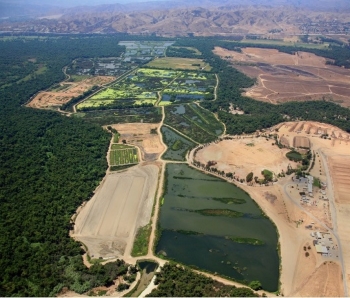
Prado Wetlands
This May marks the 25th anniversary of American Wetlands Month, a celebration of
the importance of wetlands to the nation's economy, ecology and social health. American
Wetlands Month was created in 1991 by the United States Environmental Protection
Agency (EPA) and its federal, state, tribal, local, non-profit, and private sector
partners.
During this month, Americans are encouraged to discover and educate others about
the critical role that wetlands play in the environment and the significant benefits
they provide — increased water storage and supply, improved water quality, reduced
flood and storm surge risk, opportunities for recreation and cultural pursuits,
and critical habitat for plants, fish, and wildlife.
According to EPA: Wetlands are the vital link between land and water, where the
flow of water, the cycling of nutrients, and the energy of the sun meet to produce
highly productive ecosystems with unique plant and animal life. Wetlands may not
be wet year-round. In fact, some of the most important wetlands are seasonally dry
transition zones. As nurseries of nature, wetlands are among the most biologically
productive natural ecosystems in the world, comparable to rain forests and coral
reefs in their productivity and in the diversity of species they support.
Important wetlands research is happening across the country. OCWD operates the largest
constructed wetlands, the Prado Wetlands, in Southern California. They are located
upstream of the Prado Dam in Riverside County.
Modified from a series of duck hunting ponds located adjacent to the Santa Ana River
in 1992, the Prado Constructed Wetlands (PCW) is a system of treatment ponds designed
to remove nitrate and emphasize the characteristics of natural wetland ecosystems.
A network of levees, weirs and conveyance piping control water flow through the
ponds where it undergoes sedimentation, assimilation, adsorption, and denitrification
treatment processes, all of which are specifically designed to remove nitrogen and
other pollutants from tertiary-treated wastewater in the Santa Ana River.
On average, Prado wetlands removes approximately 30 tons of nitrate a month by reducing
nitrate in Santa Ana River flow from 8 milligrams per liter (mg/L) to less than
1 mg/L during summer months. Although the flow upstream of Prado is meeting Regional
Water Quality Control Board (RWQCB) Objective of 10mg/L for the river, the OCWD
Groundwater Basin objective for nitrate is 3.4 mg/L, making removal of nitrate in
the wetlands an important factor in meeting basin water quality objectives.
In addition to nitrogen, significant reductions in other pollutants following treatment
in wetland ponds include pharmaceuticals and synthetic organic compounds. With the
ultimate use of this water to re-supply the OCWD groundwater basin, these studies
highlight the value of the wetlands as a natural water treatment process and protective
barrier to limit pollutants.
Currently, the Prado Wetlands are part of a nearly two-year-old pilot project performed
in conjunction with the National Science Foundation (NSF) supported Engineering
Research Center (ERC) for Re-Inventing the Nation's Urban Water Infrastructure (ReNUWIt).
ReNUWIt is comprised of researchers from Stanford University, UC-Berkeley, Colorado
School of Mines, and New Mexico State University. Known as the Prado Open Water
Unit Process (POWUP) project, it is investigating the use of vegetation-free, shallow
ponds to provide a potentially broader range of water treatment benefits to Santa
Ana River flows with reduced maintenance costs. Three 800-foot-by-100-foot POWUP
test cells are currently in their second year of operation.
There is a lot to learn about wetlands and why we need to preserve, protect and
expand them. Information about wetlands and the important benefits they provide
can be found in EPA's
wetlands fact sheets
series, or by visiting the websites of
its partners.
To find a wetland near you, consult your local parks department, state natural resource
agency, or the
United States Fish and Wildlife Service.
To learn more about what you can do to help protect and restore these valuable natural
resources in your local area, visit
What You Can Do to Protect and Restore Wetlands.